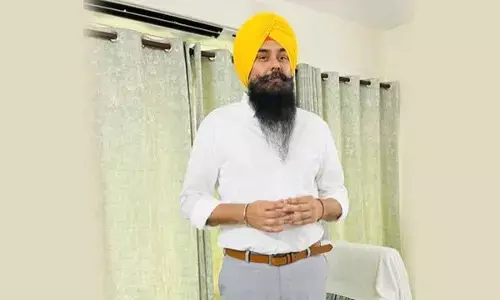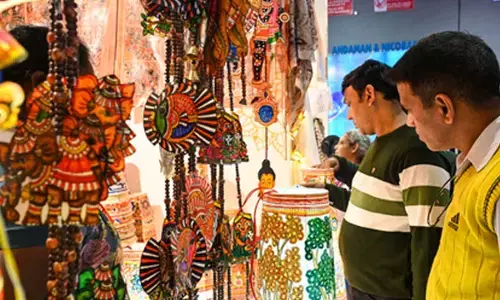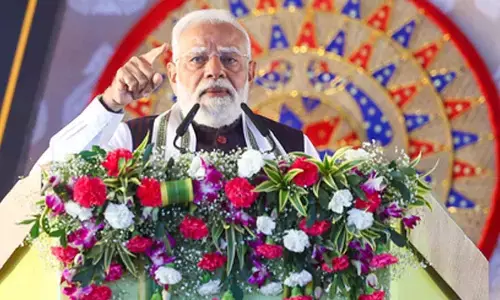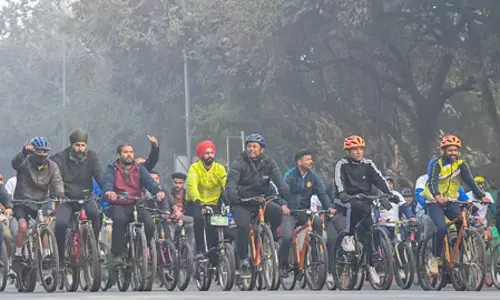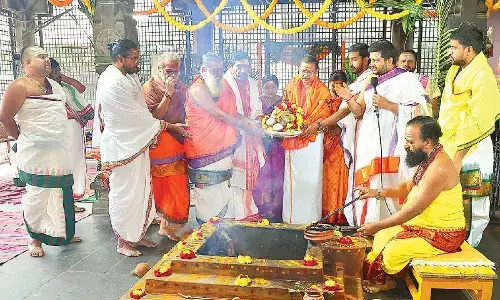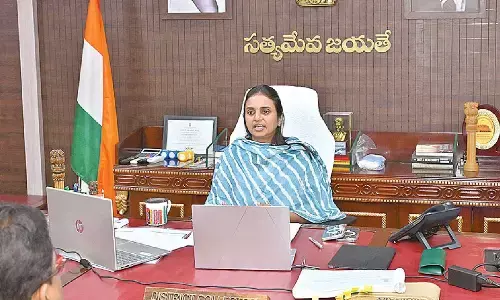Recreating the magic of yesteryears

Spanish cinematographer Dani Sanchez-Lopez has captured the aura and charisma of yesteryears beautifully, taking the audience on a cinematic ride in the biopic of actress Savitri. From choosing the colour theme of the film (which goes to and from 50’s, 60’s to 80’s) to recreating the scenes of Savitri’s films,
Spanish cinematographer Dani Sanchez-Lopez has captured the aura and charisma of yesteryears beautifully, taking the audience on a cinematic ride in the biopic of actress Savitri. From choosing the colour theme of the film (which goes to and from 50’s, 60’s to 80’s) to recreating the scenes of Savitri’s films, Dani has left no stone unturned to retell of memories of the legendary actress. Dani shares that he had a great rapport with the director Nag Ashwin and both have had many discussions to shoot each and every frame in the film.
Excerpts:
You have chosen film stock to shoot ‘Mahanati’ to give that retro look. Is it not possible to create the same feel in digital?
There is something inherently beautiful and unique about a physical canvas. The analogue film gives you the range of colour and light to just sit back and contemplate. Digital aims constantly towards the 'fire film', but at the end, a bulb is a bulb.
We wanted to really take the audiences back to the early 80’s for Samantha’s and Vijay’s part of the story, with the strong grain from the faster stocks that were introduced in India around that time, and we had the luxury of actually shooting film stock.
To make it more organic, we used a different approach to lighting altogether and a restrained handheld camerawork. In this ‘Citizen Kane’ structure, Savitri’s story is the retelling of memories filled with nostalgia. We wanted a punchier look, but still cinematic. We decided to go for the dynamic range of Alexa and the beautiful rendition and textures of the anamorphic lenses Hawk V-Lite.
Tell us about the colour theme you have chosen for the film? What went behind while choosing it?
Colours evoke an emotional response subconsciously. Nagi told me he wanted to try a colour palette for the film, which is difficult in India, where everything seems to happen in the realms of chaos and last-minute decisions. We worked really hard on it, and tried to find one way by dividing the film by eras: 40’s-50s-60s… Until we realised we needed to craft a colour evolution that followed Savitri’s psychological journey.
I brought to the table the figure of Natalie Kalmus. Another very powerful woman. She was the wife of the inventor of Technicolor. She was a very controversial character because she controlled colour in Hollywood for years. We had to find a colour palette that worked both for Indian and Western cultures, so we had a lot of discussions.
The hues begin with organic colours from her village, earthy greens and browns. Once she moves to the city, the colours bloom into warmer pinks, oranges and yellows and... As Savitri finds love, red and maroons start seeping into the frame. The rise of Savitri is traced by golden and brighter tones. Lighting becomes classical, and she becomes the one moving the baroque camera movements.
But alas, not everything that shines is gold, envy will grow in Gemini, and we see teals and greens flourish. Greens and gold in ‘Mahanati’s costumes are used, as it is an auspicious colour in Asia, mixed with oppressive light in strong teals and warm yellows that give a sensation of claustrophobia.
Until she makes the personal decision to start drinking on her own… it is the beginning of the end, the fall from grace… blue suddenly appears in the frame like the note we have been missing this whole time in the composition.
In our research, we discovered that the first layer of film, the one that touches the light first, and thus the one that deteriorates earlier, is blue (no wonder we only have 2 per cent sensitivity to blue in our eyes compared to other colours). Colour is psychological and our cultures add a different meaning to them, but there is sort of a common link of “warmer tones” to fire light and joy, and “cooler” hues to rain, winter, darkness… loneliness. Blue is the colour of her weakness, of her limitation and fear. Low key lighting with deep shadows assist the baroque camera that now circles a hieratic Savitri, stagnated into the fountain, where there used to be a river.
We chose to avoid blue during production until that moment in the story. This was a hard choice. We did not want to add a tint to create an Instagram filter or effect, we wanted this feeling to be organic and integral to the image. And we made it really tough on Indrakshi’s costumes and Shivam’s production design, who not only had to find the perfect fit for the time in the film, the time in the story but also fit the colour palette. When Mak (Makarand Surte), our amazing colourist, and I were working at the colour grading at Red Chillies, we discovered how powerful this progression becomes.
What challenges did you face while shooting 'Mahanati'?
‘Mahanati’ has been one of the longest projects I have worked for. We shot over 160 long days and nights during the course of a whole year. Maintaining visual consistency was tough, I wonder how Keerthy managed… One of the major differences with filming in the West is how much of the responsibility falls on you, as a cinematographer. In ‘Mahanati’ I have operated the camera and I have designed the lighting of every scene myself, whereas abroad I would have delegated to an operator and a gaffer.
For ‘Mooga Manasulu’, though, one of the, literally, “largest” challenges of the film, I called Hitesh, a gaffer from Mumbai. We were working in the largest studio set in Ramoji Film City, and probably of India, and the “stairway to heaven” we constructed was almost as big as the floor! It was really difficult to light it from where I wanted to direct the source and I had only seen the model and measures that Shivam and Avinash had explained to me.
I was shooting in another large location… the church scene with Samantha and Vijay with double the amount of lights we usually work with, while Hitesh was helping me with a gigantic grid set up via overhead diagrams and pictures sent on WhatsApp. This has become one of the most memorable scenes for the audience, though.
Savitri is a larger-than-life character. What angles did you plan and execute them to show her persona on the screen?
Savitri has many angles in her life. She was a very complex character, and we wanted to bring all of her avatars into the light. In this film, like Orson Welles in ‘Citizen Kane’, Keerthy went through a transformation to look like Savitri, as well as a whole progression of the different stages of her life. From the naive village girl to the astounded amateur, to the lover, to the mother, to the woman, to the person Savitri was, the person she wanted to be, and Mahanati, the person people wanted her to be.
To tell her evolution through visuals, the makeup, hair and costume team did a terrific job, joining forces with vfx and using prosthetics to make her grow as she starts drinking. We lit her very different in real life in contrast to when she was acting. We preserved the way she liked to be photographed. We also used wider or more telephoto lenses, different camera movement, and a progression of different diffusions, in light, in the air (different sorts of smoke/mist/rain), and on camera (filters and even Vaseline!) to go through her emotional journey.
And mostly, low angles as a way to give us, the audience, the comfort of our usual movie theatre view, in the Ozu fashion, or the Valle-Inclán theory.
What kind of prep did you do before the commencement of the film?
I like to read the script several times and talk to the director about what kind of visual design to go for the film. Nagi is a very visual director and the script transpired that sense, where the dialogue was just a punctuation for amazing visual storytelling. Our ideas about the movie were not far, even when we were physically distant when we started working via Skype LA vs Hyd.
This was unlike any other project that I had taken before. We not only had to talk of films as references but also of the films she had made as a base to work on her character, life’s journey and visual language. I had the pleasure of watching and studying the masters of Telugu and Tamil golden era, some of them lacking subtitles, or in really poor quality, which was a shame. I was talking to the National Film Archive of India and Kodak, and apparently, there is a plan in action to recover these films, but I hope the nostalgia of the audience can expedite this process because there are some amazing gems that need restoration.
I dived in and discovered that Savitri liked to be photographed in a very particular way. I tried doing justice to the works of the masters and what was my surprise when Singeetham Srinivasa Rao actually complimented my work on the set of our new revamped ‘Mayabazaar’! He told me I had set the light precisely in the same manner Marcus Bartley used to do for Savitri. That was certainly a highlight.
How did you communicate with the director to design a visual strategy for a film? What do you think the relationship between a director and a DP should be? How was yours with Nag on the sets?
The collaboration between a director and his DOP can be very convoluted. We have a lot of power on set and it can be a war zone... But both Nagi and I are people who leave their egos out of the set. After the first few days, I remember him asking me what I thought we could improve.
I guess I was brutally honest in my constructive criticism, and so was he. I think we really appreciated that, and from then onwards we built a relationship in which we can be quite blunt to each other, reaching the limits of politeness, but always in a constructive manner, because we give our best to the film. We both understand visual language and how film works well, so we could step on each other’s toes and be grateful for it. Even now we have finished the film we continue the conversation… should we have fleshed this part out, should we cut this part and bring this scene back…
Nagi listens to everyone and simmers everything quietly. Like Duchamp, less is more for him. He will only talk to you when he has made a decision, which is sometimes last minute… but the correct one.
Who are your influences?
I grew up with Velazquez, Goya, Matisse, Picasso, Michelangelo, El Greco, Caravaggio… dissecting a lot of art. Both my parents are high school teachers and they love travelling and art, and I was a shy kid, so I also watched a lot of films. My aunt introduced me to classics: Chaplin, Saura, Berlanga, Erice. And my uncle had a Beta tape collection that I would devour with him at age 7 when I waited for the orange to appear in the Clockwork Kubrick cult. I still remember the first dolly in Keaton’s classic, ‘Blade Runner’, or 2001. Very stark imagery.
In cinematography, I admire the work of Toland, Cortez, Cuadrado, Almendros, Subrata Mitra in India, who set up a whole grammar of how films should be told.
In terms of inspiration for ‘Mahanati’, we looked at ‘Citizen Kane’ and how it transpires in ‘Kagaaz Ke Phool’. ‘Iruvar’ had some amazing scenes by Santosh Sivam, and Nagi and I love the work that Ravi Varman did in ‘Barfi’. And we obviously looked closely to the classic masters of Telugu film industry paying special attention to Marcus Bartley.
What are your future projects?
I am flying in a few days back to Los Angeles, where I need to start the preproduction of my next feature film, ‘Miseducation of Bindu’, by Prarthana Mohan, a Tamil director I have been working with since we met in film school at Chapman University. It is a high school dramedy of female sexuality with some LGBTQ tinges, and with an Indian-born female protagonist that enters American public high school for the first time. The project is hilarious and devastating. We are aiming at only 18 days of production, what a change! And we have some stars as supporting actors. The Duplass Brothers are behind the production.
I would love to repeat and shoot another great project in South India. I arrived in India in 2011 longing to capture the stories that were unravelling in front of my eyes as I was exploring and understanding the country. The stories are out there, and more people need to dare and write them down. I would love to find another project that thrills me with its visual storytelling.








